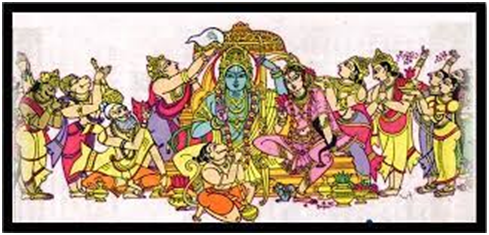Mahāpuruṣa Lakṣaṇa of
Śrī Rāma
By Smt B. Lakshmi Ramesh
Since time immemorial, there have been many chronicles that captured the imagination of the world, yet perhaps there is none to rival the perennial appeal of the Legend of Śrī Rāma, which is said to have transpired a staggering 18 million years ago, in Tretāyuga of 24th Mahāyuga in Vaivaswata manvantara, to be precise!
His extraordinary saga, at first narrated by Sage Vālmīki, and subsequently retold by many other inspired poets & epic writers, countless times over past thousands of years, still carries the same magic and relevance even today! Such is the sway of Śrī Rāma, and his strange connect with people, that they never tire of taking his name, again and again, whether in pleasure or in pain, during birth or death...whatever might be the emotion or occasion ... this is the one name that clings to the soul!! This is a humble attempt to unravel the enigma of Śrī Rāma’s eternal charisma, which seems to endure beyond all limitations of Time.
Hamsa Mahāpuruṣa Yoga
Sva (self) is Lagna, and with an exalted 9L Jupiter in Lagna in digbala, conjunct Lagna Lord Moon in own house in Gajakesari Yoga promising everlasting fame, Śrī Rāma is revered as an embodiment of Dharma (Rāmo vigrahavān dharmaḥ) and bears the distinct stamp of the quintessential Hamsa Mahāpuruṣa. This Yoga, which exhibits the exceptional strength of Jupiter in the chart, confers respect in society and bequeaths a magnetic personality, good looks, high intelligence, spirituality, great knowledge, wisdom, righteous disposition, pure thoughts, luck, wealth, exalted position in life, devoted spouse, children, success and great achievements. This yoga also blesses the native with an incredible amount of emotional intelligence, which can give strong social connectivity and an ability to use his knowledge for the welfare of society and the underprivileged. The powerful ākāśa tattva bestows certain strength and invincibility on the native and it is very difficult to oppose a person with Hamsa Yoga and defeat him.
Avatāra Aṅga Lakṣaṇa (Physical)
Śrī Rāma was described as ‘pumsām mohana rūpāya’, as one, whose handsomeness attracted even men, alluding indirectly to the vedantic principle that the only real Male in the world is the Paramātma and all jīvātmas, irrespective of their physical gender, are only considered as females. Another striking allusion is to the Mohinī avatāra of Mahā Viṣnu in which he slayed the demons Rahu & Ketu and ensured that Amrita reached the right & the deserving. This particular female avatāra of Viṣnu was said to be so enchanting that even the Adi Yogi Śiva succumbed to her charm. Mohinī represents the power of Māya (illusion), which can beguile even the wisest! Śrī Rāma was called ‘Māyā Mānusha Vigraha’, because by claiming, behaving and grieving for Sītā, like an ordinary human being, he entirely veiled his essential nature. But the one thing which instantly gave away his inherent divinity was his magnificent physique, possessing all the 32 sāmudrika lakṣaṇa (physical characteristics) that distinguish Viṣnu avatāra as mentioned in the 22nd chapter of Garuda Purāṇam.
The same was echoed in Hanumān’s portrayal of Śrī Rāma to Sītā in 35th Sarga of Sundara Kānda of Vālmīki Rāmāyaṇam.
Mahāpuruṣa Lakṣaṇa (Character)
को न्वस्मिन् साम्प्रतं लोके गुणवान् कश्च वीर्यवान् |
धर्मज्ञश्च कृतज्ञश्च सत्यवाक्यो दृढव्रतः || १-१-२
kaḥ nu asmin sāṃpratam
loke guṇavān kaḥ ca vīryavān |
dharmajñaḥ ca kṛtajñaḥ ca satya vākyo dhṛḍha vrataḥ || 1-1-2
Who really is
that person in this present world, who is virtuous and vigorous, a
conscientious one, one who is mindful of good deeds done to him, and also a
speaker of truth and who is determined in his deed... [1-1-2]
चारित्रेण च को युक्तः सर्वभूतेषु को हितः |
विद्वान् कः कः समर्थश्च कश्चैकप्रियदर्शनः
|| १-१-३
cāritreṇa ca ko yuktaḥ
sa^^rva bhūteṣu ko hitaḥ |
vidvān kaḥ kaḥ samarthaḥ ca kaḥ ca eka priya darśanaḥ || 1-1-3
Who is appropriate
in disposition... who is interested in welfare of all beings... who is adept
and also an able one... also uniquely pleasant to look at... [1-1-3]
आत्मवान् को जितक्रोधो द्युतिमान् कोऽनसूयकः |
कस्य बिभ्यति देवाश्च जातरोषस्य संयुगे || १-१-४
ātmavān ko jita krodho
dyutimān kaḥ anasūyakaḥ |
kasya bibhyati devāḥ ca jāta roṣasya saṃyuge || 1-1-4
Who is that
self-composed one, who controlled his ire, who is brilliant, non-jealous and
whom do even the gods fear, when provoked to war... [1-1-4]
1 गुणवान् guṇavān (virtuous)
2 वीर्यवान् vīryavān (Strong, vigorous, assertive)
3 धर्मज्ञ: dharmajñaḥ (conscientious, knower of Dharma)
4 कृतज्ञ: kṛtajñaḥ (grateful, mindful about help received from others)
5 सत्यवाक्य: satyavākyaḥ (speaker of Truth)
6 दृढव्रतः dhṛḍha vrataḥ (firm / steadfast observance of sacred rites)
7 चरित्रवान् - caritravān (full of
character)
8 सर्वभूतेषु हितः sarva bhūteṣu hitaḥ (interested in
welfare of all beings)
9 विद्वान् vidvān (learned,
scholarly)
10 समर्थ: samarthaḥ (capable, efficient)
11 एकप्रियदर्शनः eka-priya
darśanaḥ ( unique good looks /personality
that people loved to watch)
12 आत्मवान् aatmavān (established
in his Soul)
13 जितक्रोध:
jitakrodhaḥ (one
who had overcome anger)
14 द्युतिमान्
dyutimān
(Resplendant, Full of Light)
15 अनसूयकः anasūyakaḥ (non-envious, non-covetous)
16 बिभ्यति देवा:
bibhyati devāḥ (whom
even gods fear, when he is provoked)
These 16 divine qualities (Ṣodaśa kaḻā prapūrṇa like the Full
Moon) enumerated by Sage Vālmīki are applicable to both the Puruṣa & the
Puruṣottama. These śloka literally trace the advent of the Nirguṇa Parabrahma, descending
as an avatara, into the Saguṇa Brahma form, because the very first of the 16
qualities mentioned by the Maharṣi is ‘guṇavān’! Thus, Śrī Rāma has the unique
distinction of being emulated and adored both as human & divine ...He is ādarśa as the ideal man & ārādhya
as the pūrṇa avatāra!
मंगळम् कोसलेन्द्राय महनीय गुणात्मने।
चक्रवर्ति तनूजाय सार्वभौमाय मंगळम्।।
वेदवेदान्त वेद्याय मेघश्यामल मूर्तये।
पुंसां मोहनरूपाय पुण्यश्लोकाय मंगळम्।।


